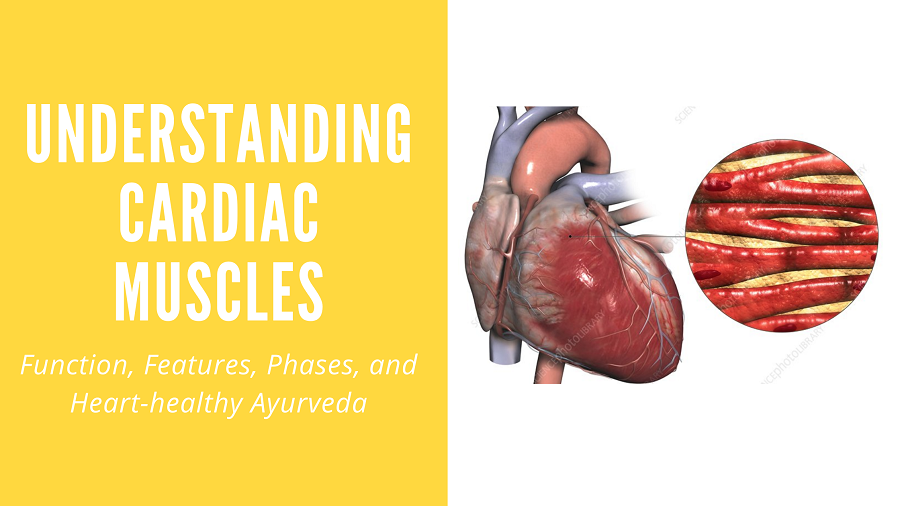Healthy living begins with a healthy heart. The key to a heart-healthy lifestyle is understanding the heart and how it works, making the right lifestyle choices and taking smart measures to reduce your heart disease risk.
What is the Cardiac Muscle?
The cardiac muscle, also called the “myocardium”, makes up the thick middle layer of the heart. Holding the prime cardiac position, the cardiac muscle is responsible for keeping the heart pumping blood around the body. It is one of three major types of muscle in the body, along with skeletal and smooth muscle.
Cardiac muscle is made from cells called cardiocytes. Cardiocytes are branched, connecting with several other cardiocytes, forming a network that facilitates coordinated contraction. Not to be confused with cardiac sphincter, also known as the lower oesophageal sphincter, is located between the esophagus and the stomach.
The involuntary contraction and relaxation of the cardiac muscle rapidly pump the blood throughout the cardiovascular system. To accomplish this, the structure of the cardiac muscle has distinct features that allow it to contract in a coordinated way without getting fatigued.
The individual cardiac muscle cell or cardiomyocyte is a tubular structure composed of chains of myofibrils, which are rod-like units within the cell.
Give three features of cardiac muscle
The properties of cardiac muscle include-
- Cardiac muscles are involuntary and intrinsically controlled.
- Cardiac muscles show rhythmic contraction and relaxation throughout life.
- Cardiac muscles have cylindrical or tubular structure cells and are uninucleate. These muscles are branched, as they are made up of several cardiocytes forming a network.
Functions of cardiac muscle
Cardiac muscle only exists in the heart. It contains cardiac muscle cells, which perform highly coordinated actions that keep the heart pumping and blood circulating throughout the body.
The Cardiac Cycle
The cardiac cycle is the process of alternating contraction and relaxation of the heart to pump blood throughout the body. The cycle starts at the beginning of one heartbeat and ends at the beginning of the next one. This cycle converts the deoxygenated blood to oxygenated blood in the lungs. The blood is then pumped by the heart to reach the other parts of the body through the main artery of the body called the aorta.
The cardiac cycle can also be described as the sequence of electrical and mechanical movements that happen with each heartbeat. The normal duration of a cardiac cycle for a heart rate of 75 beats/minutes is 0.8 seconds. It can be calculated as
Duration of cardiac cycle (seconds/beats) = 60 (seconds/minutes)
Heart rate (beats/ minutes)
Phases of Cardiac Cycle
The cardiac cycle is essentially divided into two phases, systole or the contraction phase and diastole or the relaxation phase. During the diastolic phase, the heart chamber is in a state of relaxation and fills with blood that is received from the veins. A systolic phase starts when the heart chambers are in the state of contraction and pumps the blood towards the periphery via the arteries.
Each phase is further divided into an atrial and ventricular component. Check how the cardiac cycle proceeds in four phases:
- Atrial systole: The first phase takes about 0.1 seconds, where both atria contract and force the blood from the atria into the ventricles.
- Ventricular systole: The second phase lasts about 0.3 seconds, where both ventricles contract and the blood is forced to the lungs via the pulmonary trunk and the rest of the body via the aorta.
- Atrial diastole: The third phase lasts about 0.7 seconds. Here the atria are relaxed, during which the atria fill with blood from the large veins (the vena cavae).
- Ventricular diastole: The fourth phase lasts about 0.5 seconds, getting ready for atrial systole; it allows the ventricles to fill passively with blood from the atria.
Heart-healthy Ayurveda
Ayurveda calls the heart a storehouse of energy that keeps life going. Factors detrimental to the heart’s health are
- Undue stress to the mind and body
- Poor dietary practices
- Lifestyle choices
- Emotional outbursts
Natural remedies suggested by Ayurveda ensure that the heart pumps healthily for a longer time and has no side effects. Heart health is governed by three sub-doshas, which are present everywhere in the body but have their seat in the heart. It is, hence, vital to bring about an optimum balance of these biological energies.
- Sadhaka Pitta – Associated with the emotional balance
- Avalambaka Kapha – Associated with the stability and strength
- Vyana Vata - Associated with blood flow and beat
The following natural remedies from Vedi help energize the heart and keep it safe and sound.
Arjuna Tablet - The Arjuna tree bark is cardiotonic and effectively treats heart palpitation, angina, and poor coronary circulation. It strengthens the heart muscle, regulates heartbeat, and reduces cholesterol.
Guggulu Tablet – This magic herb has properties to pacify Vata, pitta, and Kapha. Regular use of this herb can help lower cholesterol levels in the body.
Cannaflam Tablet – Cannaflam tablet is a natural Cannabis medicine that helps in managing cardiovascular conditions.
To get medical advice from our doctors or get a prescription, reach out to us by filling this form.


